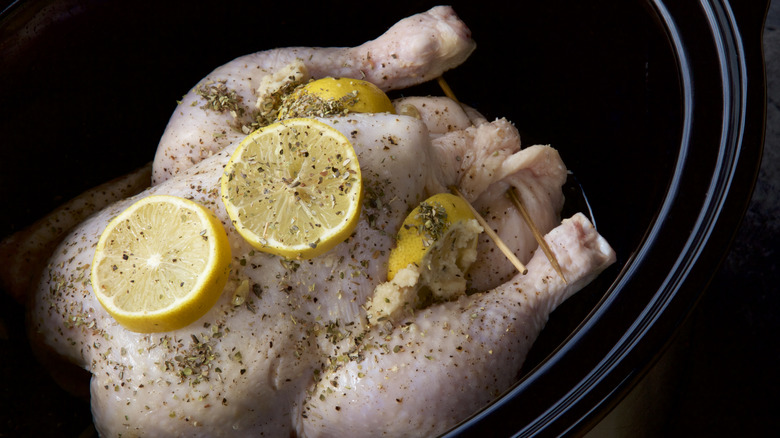There Is A Right And Wrong Time To Add Lemon To Slow Cooker Dishes
Slow cookers are a staple of many households' weeknight dinners for a few reasons — they're easy to clean and you can safely leave them plugged in while you're at work or school. But the most celebrated aspect? The simplicity and ease of slow cooker recipes. Many of the classics are one-pot meals that allow you to put all of the dinner's ingredients in at once, set it, and forget it. But when it comes to lemon, this rule doesn't hold true.
When you add lemon to a dish, it's going to look different. Depending on the recipe and what impact you want the lemon to have, you may need to add the lemon at the beginning and/or the end of your cooking. So how do you know what time is right for your recipe? That's determined by what impact you want the lemon to have. For a strong, vibrant finish, add lemon juice and a bit of zest at the end of your cook time. But for a more mellow, balanced addition, pour lemon juice in at the beginning so it will have time to intertwine with the other elements.
Knowing when to add lemon
Knowing when to add the lemon can seem tricky, but the general rule is that you should add it at the end if you want it to stand out as a main flavor component, but if you want it to soak up other flavors of the dish, be sure to add juices or toss the lemon slices in at the beginning. For example, if you want a super bright finish of citrus in a creamy lemon chicken soup, add a squeeze of lemon juice and freshly shaved zest at the end of cooking so the flavors don't become muddled. But when it comes to slow cooker lemon chicken, it's a bigger priority for the lemon to flavor the meat and mingle with the drippings. Plus, this gives the lemons time to candy, offering a milder, sweeter flavor from the fruit, so that they can be served as part of the final dish.
Additionally, understand the role that lemon plays outside of flavoring alone. Say you're making Cuban-style pulled pork, you want lemon in from the beginning to flavor the meat and break down the proteins in the pork. That, combined with a low and slow cook, is what gives you sumptuous, fall-off-the-bone pork.

